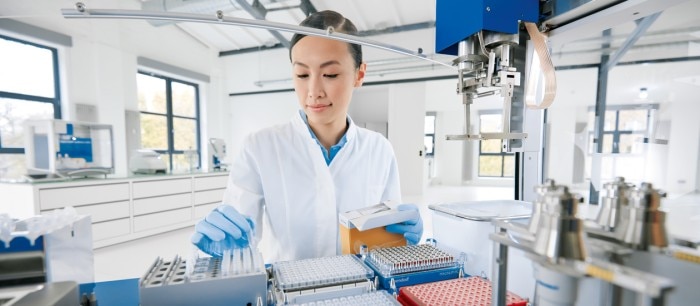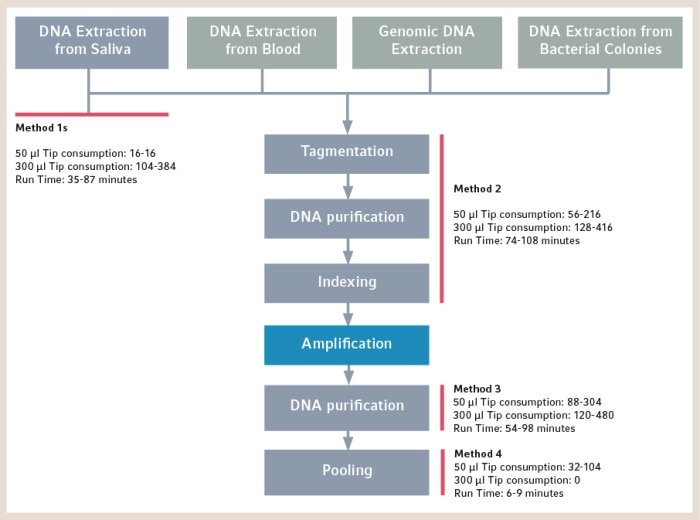MENU
CA | CAD
CA | CAD
-
- Benchtop Centrifuges
- Floor-Standing Centrifuges
- Refrigerated Centrifuges
- Microcentrifuges
- Multipurpose Centrifuges
- High-Speed Centrifuges
- Ultracentrifuges
- Concentrator
- High-Speed and Ultracentrifugation Consumables
- Accessories
- Tubes
- Plates
- Device Management Software
- Sample and Information Management
No results found
Search Suggestions

How to Facilitate Your Whole Genome Sequencing Experiment
Lab Academy
- Molecular Biology
- Efficiency
- Next Generation Sequencing
- Automation
- Liquid Handling Workstations
- Essay
Whole genome sequencing offers the most comprehensive tool for genomic studies. Yet library preparation steps, including DNA extraction, quantification, fragmentation, normalization, purification and quality control pose major labor-intensive bottle necks for the generation of such sequencing data. Usually all steps are done with the aid of a kit but still, preparing a library for whole genome sequencing takes time and is a lot of work.
Multiple kits for whole genome library preparation exist on the market. For an exemplary comparison of library preparation time, steps and costs of different kits, see table 1. With the release of the Nextera® DNA Flex Library Preparation kit, Illumina® introduced a new chemistry which streamlines these time-consuming steps into a faster, highly flexible workflow. To even further improve the library preparation, automated liquid handling systems should be used. Ideally, minimal hands-on time is necessary and the system is optimized to work with the kit. This saves preparation time and guarantees reproducibility of library preparations. Two things play important roles: Logically compartmented workflows and testing thorough or qualifying the kit method.
Read more
Read less

Logical compartmentalization of automated library prep methods helps choosing which version of kits to use, when to run samples and when to stop at safe stopping points during the preparation of a library. For the construction of 96 sequencing-ready libraries with Illumina's Nextera DNA Flex kit in less than one day we recommend automated liquid handling systems with the possibility to program 4 methods and one off-deck incubation (figure 1). This allows to stop the library preparation after one of the steps if needed. This way the automated liquid handling system can accommodate different sample inputs (e.g., 24-plex or 96-plex) and provides full flexibility to match your busy day schedule.
Read more
Read less

Figure 1: Workflow for the Nextera DNA Flex Library Preparation protocol on the epMotion® showing single steps. Red boxes show which steps are part of which method file. Steps highlighted in green are not part of the qualified method but can be performed using the epMotion. The running times on the epMotion and tip consumption are shown for handling 24 and 96 samples for each method. The complete process allows construction of 96 sequencing-ready libraries in less than a day with a hands-on time of less than one hour.
Read more
Read less
Another important aspect in downstream analysis is the consistency of automation and manual liquid transfer. When investing into automation, it is important to have as little variation as possible without wasting reagents and labor time. A proper pipetting technique for manual steps should be applied with great care and the best-fitting automation system must be chosen with focus on the application and real needs to achieve best results.
To evaluate our system, we prepared 8 libraries from 200 to 300 ng DNA from Coriell Institute female reference cell line NA12878 using Nextera DNA Flex and sequenced them in two independent experiments. The average fragment size was closely clustering around ~600 bp as recommended by Illumina. Library yields were highly reproducible and comparable to manual data. This translated to good sequencing performance data with high read diversity and even coverage across the genome and autosomes and a low coefficient of variance (CV). To read further how the epMotion can contribute to optimize your NGS experiment check our white paper.
To evaluate our system, we prepared 8 libraries from 200 to 300 ng DNA from Coriell Institute female reference cell line NA12878 using Nextera DNA Flex and sequenced them in two independent experiments. The average fragment size was closely clustering around ~600 bp as recommended by Illumina. Library yields were highly reproducible and comparable to manual data. This translated to good sequencing performance data with high read diversity and even coverage across the genome and autosomes and a low coefficient of variance (CV). To read further how the epMotion can contribute to optimize your NGS experiment check our white paper.
Read more
Read less
Illumina® and Nextera® are registered trademarks of Illumina, Inc., USA. Eppendorf® , the Eppendorf Brand Design and epMotion® are registered trademarks of Eppendorf AG, Germany.
Read more
Read less

